Shibas in gene test: colour loci
Written originally in Finnish for Shibasanomat 2/2020. The English version kindly translated by Topi Kuusinen.
Update: MyDogDNA breed database as described here no longer exists.
Update 2: Dog coat colour genetics is a developing field. An alternative classification system regarding the A locus has recently been proposed. More here.
Update 3: The hypothetical allele Ays associated with the red sesame has been found and validated in Shibas. This article is now partially outdated and may appear confusing.
Update 4: Coat color probability charts for different genotypes (based on the novel A locus classification system) are now available in the category Color Charts: https://shibalogia.info/?cat=55
Update 5: Shiba Puppy Generator is now available: https://shibalogia.info/?p=4223 Feel free to raise some litters to observe how genetics (and random luck!) affect the coat color in puppies.
This part of the gene test series discusses coat colours. The public database of dogs by MyDogDNA is a good place to study the colour genetics of Shibas, because the data usually includes, in addition to the test results, a picture of the dog as well as the official name. Currently the database includes 51 Shibas with public data.
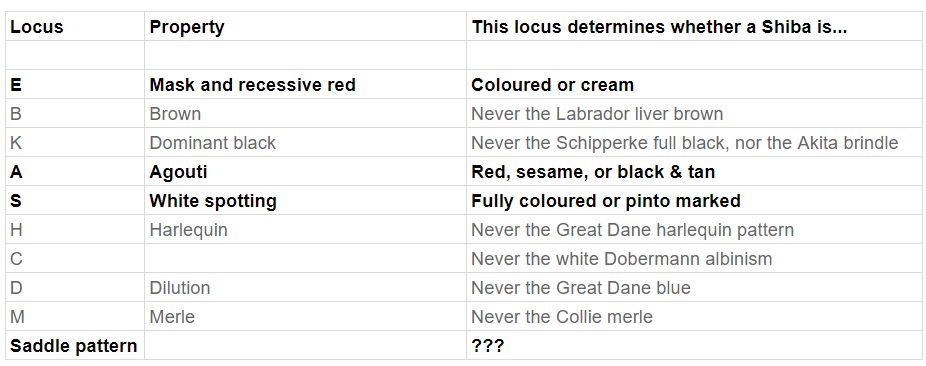
Some of the terms commonly used with Shibas are different from those in the panel, e.g. genetic sable is the same as a red Shiba. All Shibas have the same gene forms i.e. alleles for a number of colour loci, whereby these alleles are said to have fixed in the breed. Currently, there are three loci describing the changes of coat colour in Shibas (loci is plural for locus, and locus means the address of a gene or other sequence of DNA in the chromosome) that have been verified: A locus, E locus and the S locus for white spotting.
Note that gene tests do not ”read” the whole gene. They are designed to detect certain mutations only. Other mutations may be present in the gene yet gene tests do not know to look for them. Is is often unclear whether the detected mutation causes the associated trait, or if it is just a coincidental marker mutation inherited together with the actual causal mutation.
A locus and the base colour of coat
Colour locus A, i.e. agouti, gives a Shiba either red, black & tan or sesame base colour. A cream Shiba is also one of these three as far as A locus is concerned, even though with cream the A locus colour cannot be expressed.
It is currently believed that at least three alleles are possible for the A locus in Shibas, the official names of the alleles differing a bit from those commonly used. Allele Ay is connected to sable colouring, but in Shibas this means red colour. Allele at, i.e. tan points, is known as black and tan in Shibas. The coat colour allele aw, found in wolves and called both agouti and wolf-grey, is connected to the agouti sesame colour in Shibas. A fourth allele could be the hypothetical Ays, which may explain the red sesame colour.
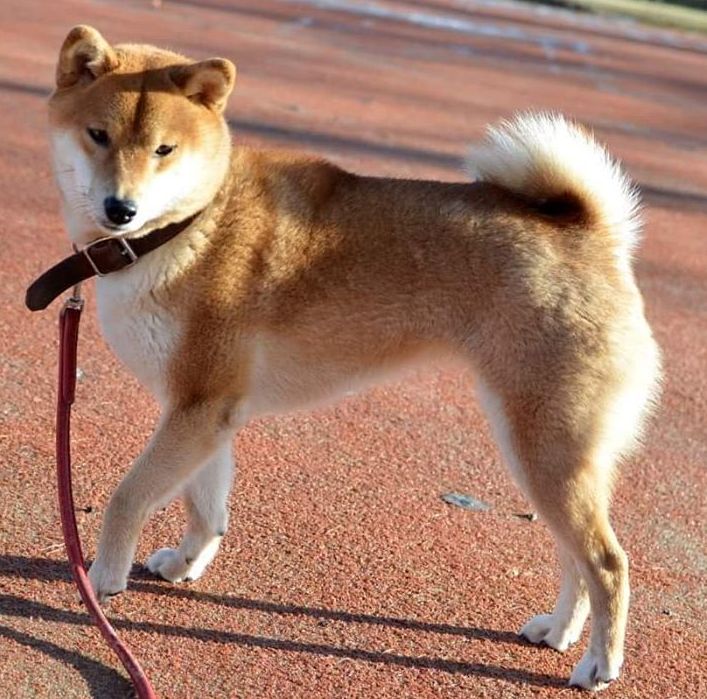
The result of the gene test shows the gene type inherited from both the dam and the sire. In a red Shiba, at least one of these is always Ay. For aw sesames the possibilities are aw/aw or aw/at. A black and tan Shiba has inherited the at allele from both parents, so its genotype is at/at. In practice, the test result for A locus is interesting when one wants to know whether a red Shiba carries B&T or sesame colour, because these both are recessive under red coat colouring. Visual recognizing of especially a carrier for sesame (Ay/aw) can be impossible. Carrying a colour has an effect on the possible colours of puppies produced by the dog.
Fun fact: In most test laboratories the allele aw of the A locus is defined by elimination. If the three other alleles (Ay, at and a) do not match, the result is interpreted as allele aw. In principle this method can produce a strange test result, if the genotype of the dog is very unusual.
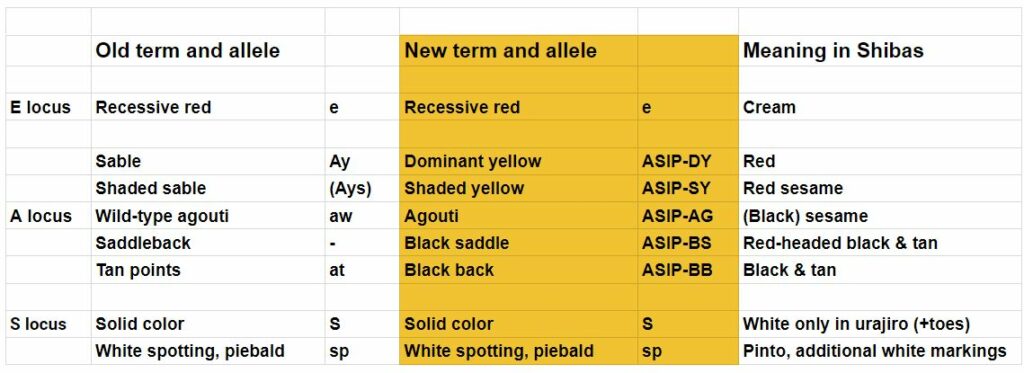
E locus and cream
The E locus at the top of the list is related to whether the base colour of A locus can be expressed. This is called epistasia, the effect of a gene to another gene. In a Shiba the options are “capital E”, i.e. coloured, or “small e”, which is expressed as cream. If a Shiba has inherited the “capital E” from at least one of its parents, it will express the colour of A locus. A Shiba with the genotype E/e has inherited colour expression from one of its parents and the cream allele from the other parent. In other words such a Shiba carries cream. Carriers of cream can often be easily discerned by their larger and brighter urajiro.
A cream Shiba can be born from a combination of two carriers for cream if the puppy happens to inherit the “small e” from both parents. In this case the colour of A locus can’t be expressed. A Shiba with genotype e/e is genetically a “recessive red” and “diluted red”, because in reality the cream (white) of a cream Shiba is a red pigment with a very light tone.
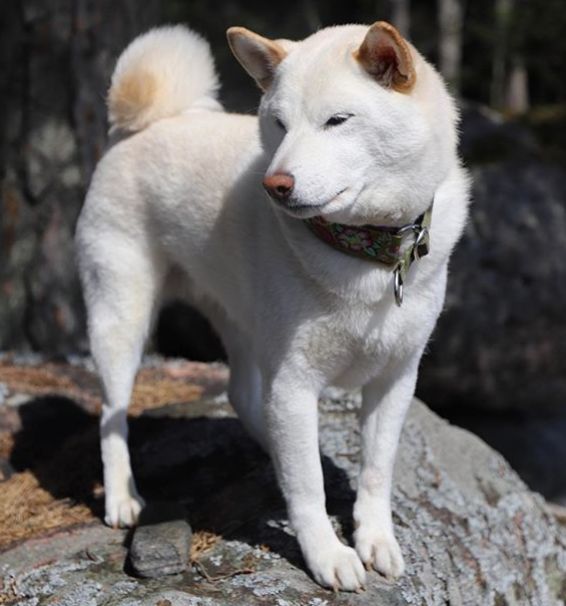
The terms recessive and diluted red are in this context only related to the red pigment controlled by the E locus. As far as A locus is concerned, a cream Shiba can be any of the three: red, B&T or sesame. The occurrence of the cream allele in Shibas tested by MyDogDNA (including both carriers and cream-coloured dogs) is nearly 25%.
It seems most likely that the Shiba gene pool lacks the E locus alleles causing the black mask (Em), sighthound domino colouring (Eg), and ancient red colouring (eA). However, new and hidden E locus alleles – currently undetected by any gene test – may still appear.
S locus and the pinto Shiba
In a developing embryo the pigment cells migrate from the top of the head and back towards the extremities. If the migration of these cells is intercepted for any reason, the skin of the dog will have areas with no pigment. The color of non-pigmented area is bright white with crisp borders in contrast to the urajiro, where the hue of the red pigment is almost off-white. Regardless of genes, small white markings can form on the chest, toes or the end of the tail, and this is called residual white.
In Shibas, large white markings outside the urajiro area are usually connected to genetic white spotting, i.e. the S locus. The ”normal” allele for the S locus is S, but Shibas can also have the allele sp, called piebald. This gene form interferes with the spreading of pigment cells.
A Shiba of genotype sp/sp can have elbow-length white socks, a spot in the neck or the body or even patterning reminiscent of that of an American Akita. In a Shiba, excessive white markings are called pinto colouring, and according to the breed standard it is a disqualifying fault.
A carrier of pinto colouring (S/sp) does not necessarily have any white markings. White ankle-length socks, a stripe on the muzzle or a spot hidden in the urajiro on the chest can, however, indicate a pinto carrier. This means that the white pinto colouring (=missing pigment) related to the S locus is different from the cream Shiba related to the E locus (=very light hue of the pigment). A cream Shiba can also have pinto colour or carry the pinto gene, even though the pinto-white areas can’t be seen in the light coat colour of a cream Shiba.
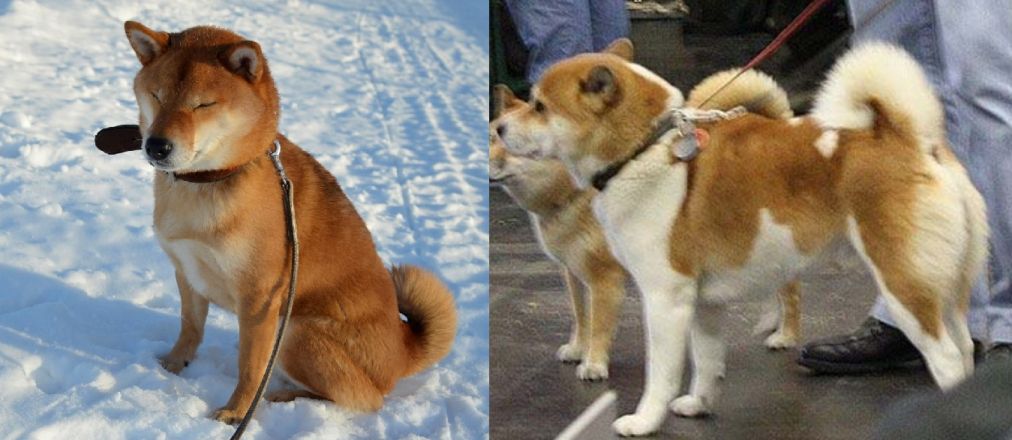
Like all other recessive traits, a pinto puppy is possible only if both parents carry the pinto colouring. In addition to the aesthetic problem, the white pinto colouring can cause health problems, because on the head it can lead to innate deafness of the dog. The occurrence of the pinto-causing allele sp is currently about 7% in the Shibas tested by MyDogDNA.
It is likely that the S locus and white spotting do not always “function” in Shibas and other indigenous Japanese breeds as expected. In some cases, a Shiba with obvious white, long socks is according to the gene test a non-white spotted S/S, and a completely coloured Shikoku or Akita can have the genetic form of sp/sp.
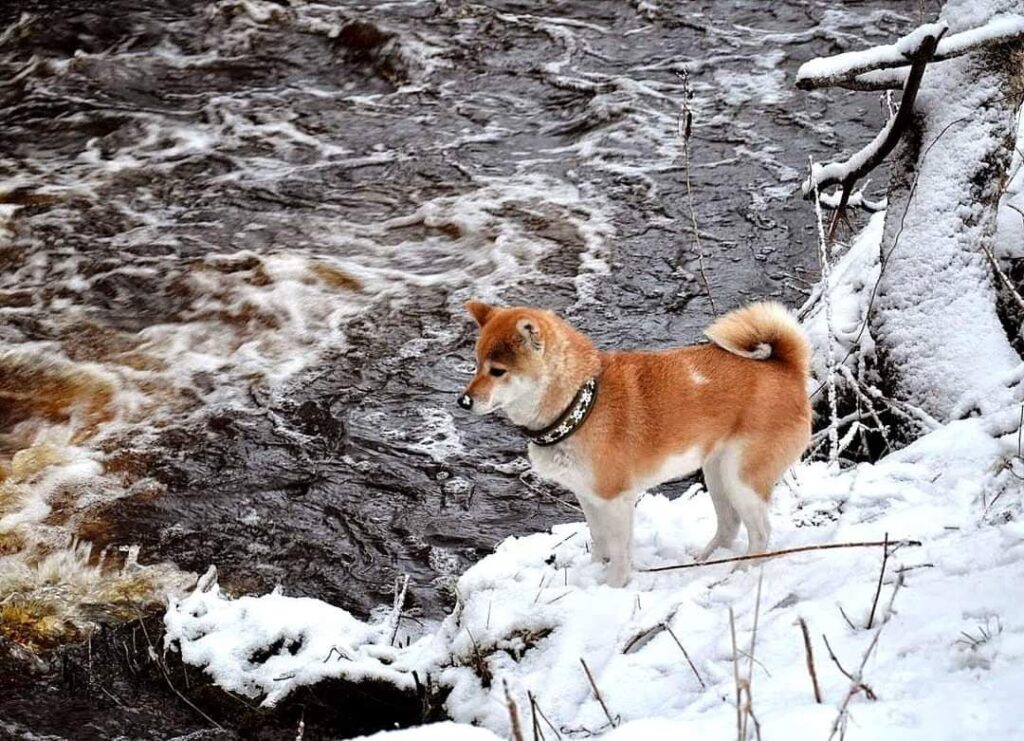
The RALY locus is still a mystery
The fourth area of the test panel with differences between Shibas is related to the saddle patterning found in Corgis and Bassets. This is the RALY locus, in which a short sequence of DNA can be duplicated. In such a case the result of the gene test is dup. The allele without duplication if marked with a dash. The Shibas in the database have the genotypes dup/dup, -/dup and -/-.
In Shibas no obvious connection to colour differences can be observed, but the duplicated gene form seems to be found in some black and tan dogs and carriers for B&T. Unlike Corgis, the B&T Shibas in the database do not express a saddle patterning even when the genotype of the RALY locus is -/- or -/dup. On the other hand, an incorrect colouring indicative of saddle patterning can sometimes be seen in non-standard Shibas (“creeping tan”).
As research progresses, it might be interesting to observe especially the test results of the rare sable sesame Shibas. The genotype -/dup of the RALY locus is connected to the so-called capped colouring in tri-coloured Corgis. The capped colouring forms a widow’s peak pattern on the dog’s forehead, typical for shaded sables (in Shibas this is typical for sable sesames). So far all four tested sable sesames have the same genotype E/E Ay/at -/dup. However, this is not a complete explanation for the sable sesame, because there are red Shibas with this genotype as well. Additionally, another issue to be noticed with the observations is that many of the tested dogs are related to each other – thus some common gene, not detected by the test, can have an effect on the colouring.
Update: As the first sable sesame Shibas with the genotype Ay/aw have now been found, it is unlikely that RALY affects the sable sesame pattern. Although the RALY genotype for these dogs is not known, the dup allele seems to appear in Shibas only in association with the at allele.
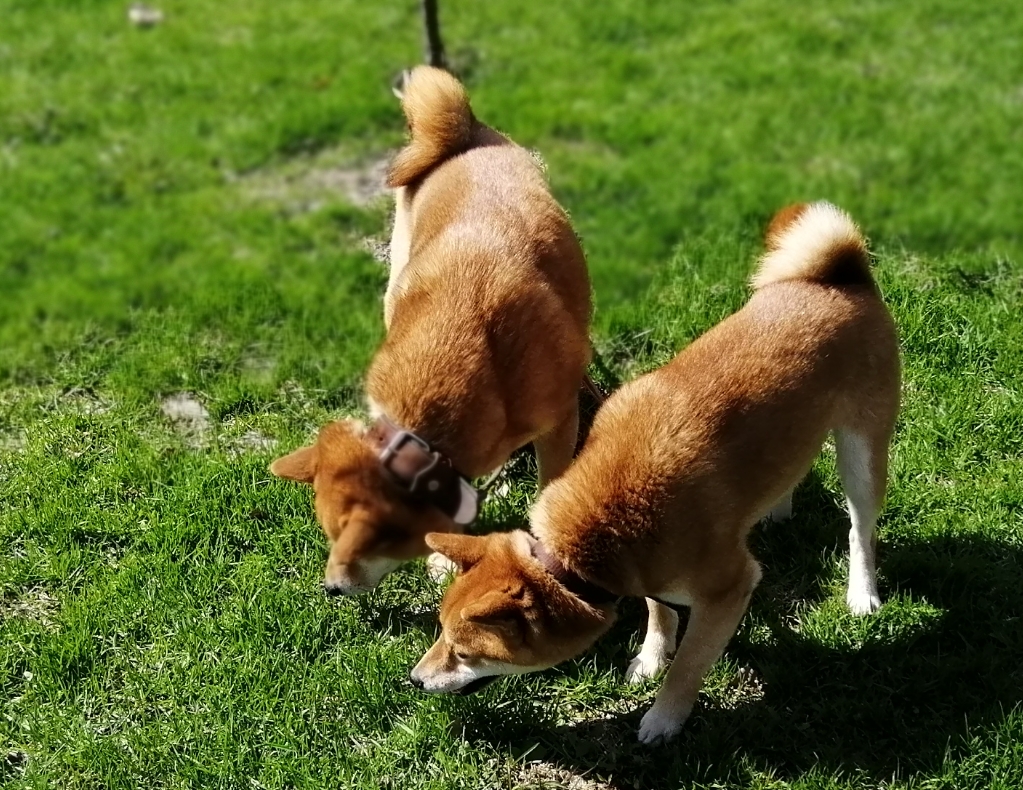
Some more information about different sesame Shibas
There are at least two different genetic bases for the sesame colour of Shibas. The well-known type of sesame colour is the aw sesame detected by the gene test. In this form the colouring is caused by the aw allele of A locus. In this kind of sesame, the black tipping of the coat in expressed on the same areas as in a B&T Shiba, extending to the top of the muzzle and near the ankles on the front part of forelegs. The hue of an aw sesame can vary from a reddish and brownish to a very dark hue, which are usually called black sesame.
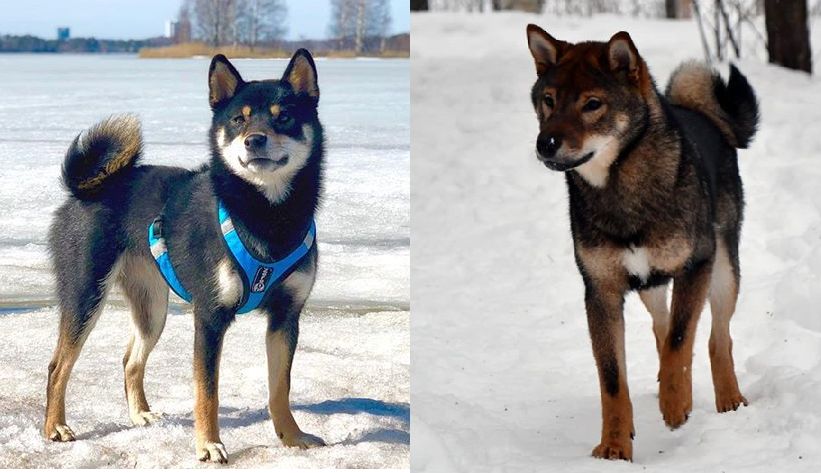
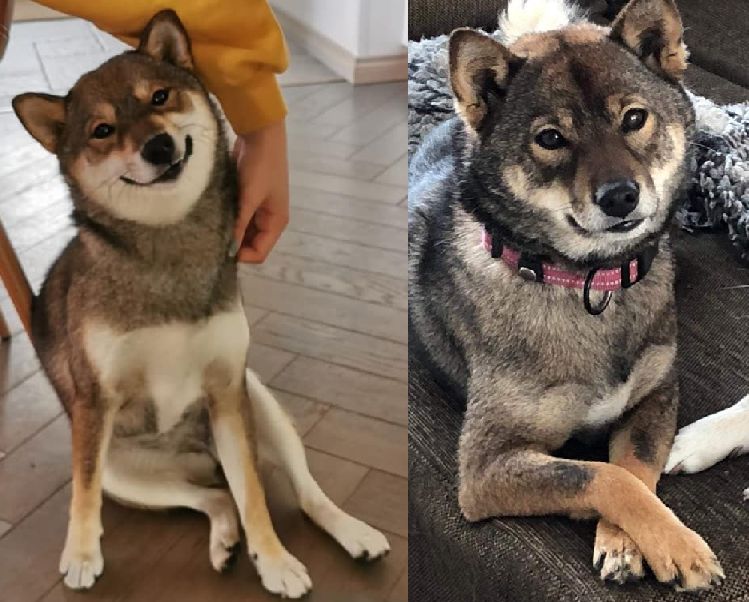
A less well-known sesame type is likely based on the Ays gene form (Ay sesame), which causes the red to be shaded by black. Current gene tests cannot detect Ays – the result is always red Ay. In this case the black shading totally covers the back and head of the dog, but does not extend far down to the legs or the top of the muzzle. On the forehead there usually is a sharp “widow’s peak” pointing towards the muzzle. The hue can be reddish brown, reddish grey or even slightly yellowish. Such a sesame has been called a red sesame (even though an aw sesame can also look reddish), a widow’s peak sesame (even though this pattern is not necessarily visible) and an Ay/at sesame (even though the colouring also seems to be possible for a Shiba having the genotype Ay/aw). Therefore the best name for this colour could perhaps be sable sesame or Ays sesame.
In other dog breeds this colour is usually called shaded sable. The genetic cause is still unknown, however, separate modifier genes or epigenetic modifications (= same DNA sequence but different activity of gene expression) have been suggested. New research has found specific gene regulation modules on A locus, which seem to differ between sable and shaded sable dogs. It is not yet clear if this new A locus system actually detects the hypothetical Ays allele.
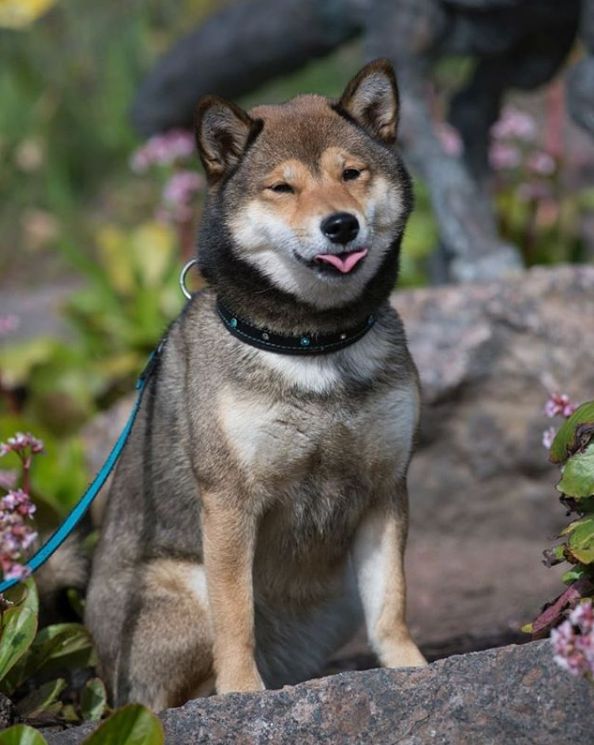
Typically the black shading of a sable sesame appears on an originally red-looking puppy only after the first puppy coat has been shed. In gene test, the sable sesames seem to have the genotype E/E Ay/at or E/E/ Ay/aw, which means that they don’t usually carry cream. It is supposed that the sable sesame phenotype is inherited with the Ays gene form, which is recessive to red (Ay) but dominant to aw-sesame (aw) and black-and-tan (at). It follows that a breeding of Ays sesame and a black-and-tan should result in puppies, which are either Ays sesame or black-and-tan. It is not yet fully clear how cream carriers or ”double-Ays” Shibas look like. Breeders of Ays sesame Shibas have reported that the hypothetical Ays gene form is actually inherited in a predictable fashion.
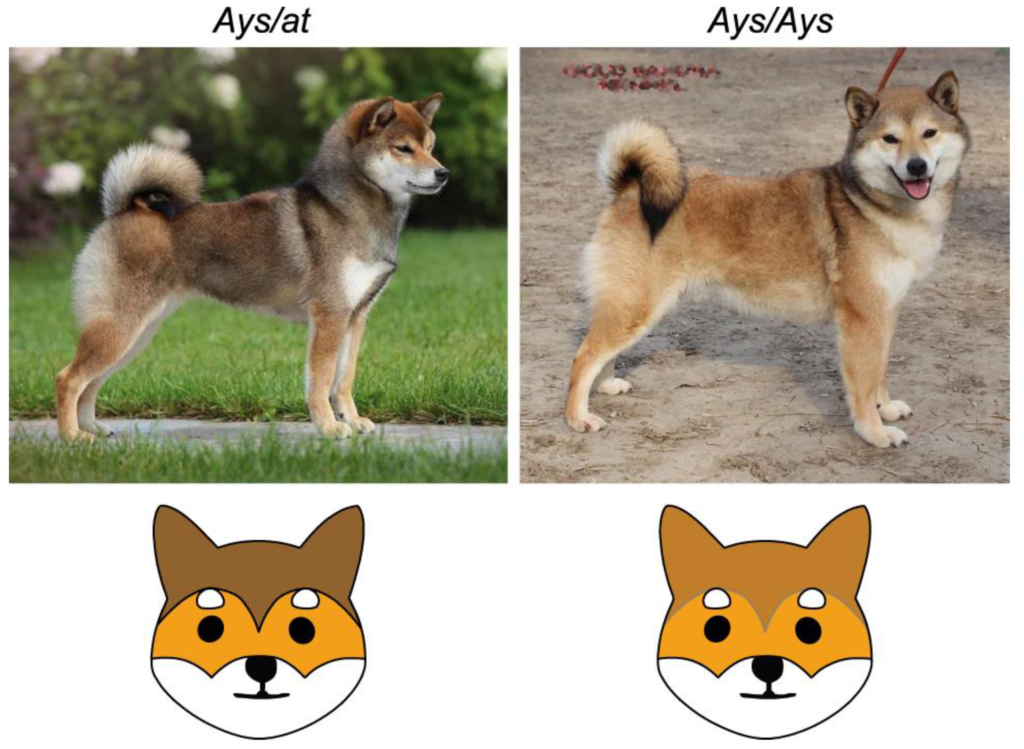
So which one is ”the real” sesame?
The answer is very simple: both sesame types are just as real sesames as long as the Shiba looks like a correct sesame Shiba. The breed standard for the Shiba, or the small Japanese dog, was written in Japan almost 100 years ago. The sesame colouring was never defined by gene tests or genotypes, but rather how the coat colours appeared to the eye. Balance – not too much and not too little – was likely the key again, and the ideal sesame colouring should not be too dark nor too light.
If we are precise, a sesame Shiba can never be ”a genetic sesame” as such a term does not exist in dog coat color genetics. Ays type sesame likely corresponds to a genetic shaded sable, while aw sesame refers to a genetic agouti.
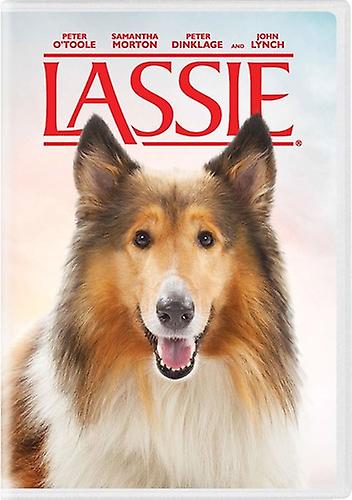
Sable sesame or sashige?
In addition to an Ays sesame, a Shiba with the gene test result E/E Ay/at can be bright red or shaded with black only on the neck and back; in Japanese “sashige”, dirty red. Even a red ”carrying red” (genotype Ay/Ay) sometimes has some black on the back or tail. There’s a rule of thumb for discerning between a sashige and a sable sesame. If you have to think about it, the colouring is sashige, not sable sesame. The difference is most clear when viewed from the front. The odds are on the side of a sashige as well, as sable sesames are very rare.
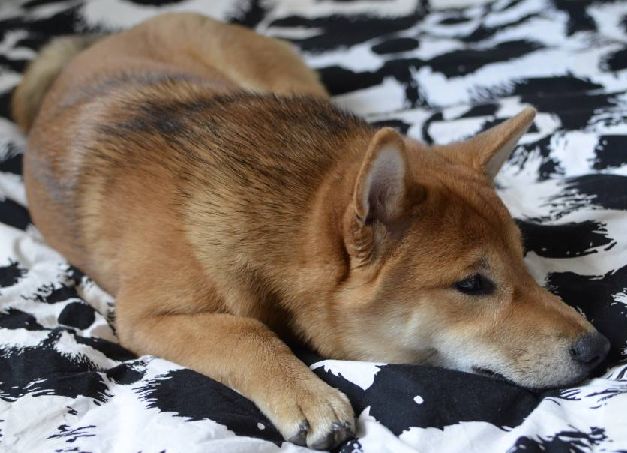
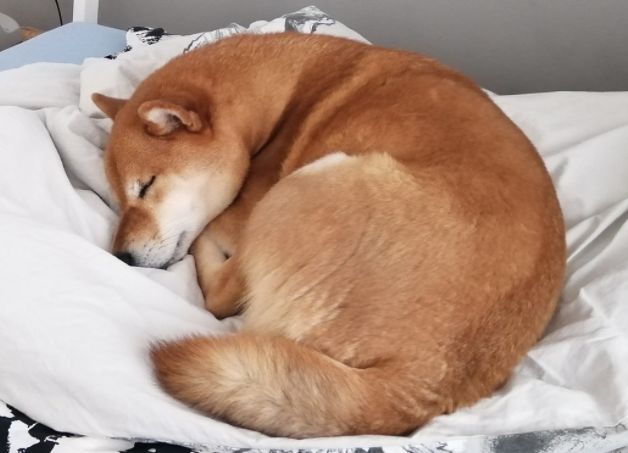
New colour loci are continuously discovered
The interpretation of the Shiba breed standard says that the ideal coat colour for a red dog is the colour of a flame or the orange of a forest fire. Current gene tests do not explain the considerable hue variation of Shibas. The number of repetitive sequences near the KITLG gene, which has an effect on pigment cells, was recently associated with variation in red pigment intensity in e.g. Nova Scotia Duck Tolling Retrievers and Poodles. Dogs with a greater number of repetitive sequences appeared to be a darker shade of red.
On the level of a single hair, the visible difference was due to the fact that in dogs with a lighter colour the pigment was unevenly distributed to a lighter root part and a darker tip part. In the darkest dogs the whole hair was evenly pigmented. No Shibas were included in the study, so it remains yet to be seen whether KITLG also has an effect on hue difference in Shibas. The distribution pattern of the pigment could be important, because a single guard hair of a Shiba of any colour should have, on a closer scrutiny, a root, a centre part and a tip.
Shiba is one of the breeds where the E locus genotype e/e, in other words recessive red, results in such a diluted red pigment that the colour is practically white. The search for the “intensity locus” causing this phenomenon has been going on for a long time.
Certain variation in the gene MFSD12 was recently associated with the extremely diluted red colour of genotype e/e dogs in e.g. White Shepherd and West Highland Terrier. MFSD12 and E locus are located in different dog chromosomes, meaning that they are inherited independently of each other. This study also included Akita, another indigenous Japanese breed, in which the occurrence of the MFSD12 ”e/e white variant” was 56.3%. This indicates that MFSD12 could, in part, be associated with the dilution of a cream Akita, but there must be additional mechanisms having an effect on the cream colour, because like Shibas, all e/e Akitas are cream. If the MFSD12 gene is included in the gene test panels, it will probably be called the I locus after the word “intensity”. The possible variation in the intensity locus in Shibas is potentially interesting in case the effect can also be seen as intensity differences in red Shibas.
Gene testing of dogs is nowadays more popular than ever, so new research results about colours are published frequently. In addition to totally new colour loci, novel alleles in previously described loci can be found. A good example of this is the recent A locus allele Ayt, i.e. recombinant fawn, in which the allele Ay for sable and the allele at for tan markings apparently form a combination.
Another updated colour locus is the D locus, which is associated with the dilution of both red and black pigment. A third variant causing dilution was recently found. This novel variant was also present at low frequencies in wolf and wolf dogs, possibly suggesting an ancient mutation. It is not yet known whether this variant exists in Shibas. Homozygous dilution variant would likely make red Shibas pale, but also dilute the black & tan colour to silvery blue. Earlier D locus dilution variants were not detected in the Shibas of MyDogDNA database.
For Shibas, relevant open questions are still the formation of urajiro and determination of the black colour shading the red coat. What is the genetic difference between a red sashige Shiba, with black colour limited to the back only, and a sable sesame Shiba, with an even black overlay? Maybe colour genetics will eventually be able to describe the mysterious sable sesame Shiba and the inheritance mechanism of this colour.
Specialties of the A locus
Our understanding about the A locus has been updated in recent years, when atypical alleles have been found in various breeds. This phenomenon is related to the recombinant fawn mentioned above, in which the alleles Ay and at are thought to have recombined (”fused”) into one. In dogs of so-called A3+ genotype the presumed recombination can be present in one or both homologous chromosomes. In this case the dog is thought to ”contain” three or four A locus alleles (or, at least, their characteristic parts) instead of the usual two. It is not yet known how the recombination affects the gene expression of these alleles. Examples of A3+ dogs and their visible colours in different breeds:
⦁ Allele combination Ay/Ay/at, sable colour: Boston Terrier, East Siberian Laika, Pyrenean Shepherd, Tibetan Mastiff, Tibetan Spaniel, Whippet
⦁ Allele combination Ay/at/at, tan markings: East Siberian Laika, Tibetan Spaniel
⦁ Allele combination Ay/at/at, sable colour: East Siberian Laika, Tibetan Mastiff
⦁ Allele combination Ay/at/at/at, sable colour: East Siberian Laika
⦁ Allele combination Ay/Ay/at/at, sable colour: Whippet
In Tibetan Spaniels the colour-defining allele of A3+ dogs seems to be the one with two copies. In other breeds the principle is different. In Japanese breeds the “three-part” Ay/Ay/at genotype has already been found in Kai Ken.
Sources and other reading material
A Simple Repeat Polymorphism in the MITF-M Promoter Is a Key Regulator of White Spotting in Dogs (Körberg et al., 2014)
A Third MLPH Variant Causing Coat Color Dilution in Dogs (Van Buren et al., 2020)
Atypical Genotypes for Canine Agouti Signaling Protein Suggest Novel Chromosomal Rearrangement (Dreger et al., 2020)
Comprehensive genetic testing combined with citizen science reveals a recently characterized ancient MC1R mutation is associated with partial
recessive red phenotypes in dog (Anderson et al., 2020)
Dog Coat Colour Genetics website http://www.doggenetics.co.uk/
Facebook group Sesame Shibas from all over the world – Unite!
Identification of a Missense Variant in MFSD12 Involved in Dilution of Phaeomelanin Leading to White or Cream Coat Color in Dogs (Hèdan et al., 2019)
Identification of a Mutation That Is Associated With the Saddle Tan and Black-And-Tan Phenotypes in Basset Hounds and Pembroke Welsh Corgis (Dreger et al., 2013)
MyDogDNA database
Pigment Intensity in Dogs Is Associated With a Copy Number Variant Upstream of KITLG (Weich et al., 2020)
True Colors: Commercially-acquired Morphological Genotypes Reveal Hidden Allele Variation Among Dog Breeds, Informing Both Trait Ancestry and Breed Potential (Dreger et al., 2019)
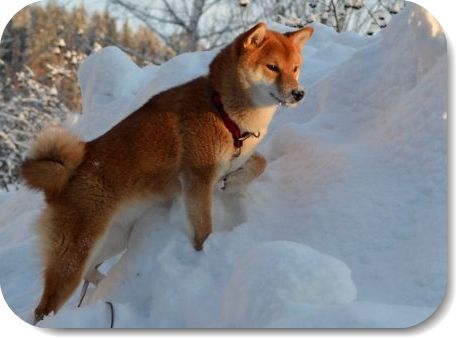

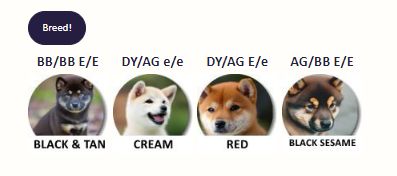
Hi, thank you for your post. It’s very interesting for Shiba owners. How do you know that 51 Shibas are in that database? My dog has 2 copies of Saddle Tan. Why isn’t she show up the saddle back? Do you have any ideal? Kind regards, Hai
Hi! Thanks for visiting my blog! This post from 2020 is not up-to-date about all things. There was an open database of tested dogs at MyDogDNA before but we can’t look at them anymore, which is a pity. As for your Shiba, I predict he/she is a black and tan and you are talking about the RALY mutation of saddle tan? I think that gene test did not work for all breeds because the RALY mutation was just a marker, not what caused the saddle. It is now also old information. The new promoter system of A locus gene testing (including the gene test for black saddle, ASIP-BS) should be more reliable.
Satu